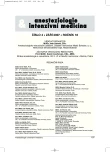Influence of low dose ketamine on anaesthesia for bronchoscopic procedures
Authors:
Ondřej Marek; M. Adamus; Z. Mrozek
Authors‘ workplace:
Klinika anesteziologie a resuscitace Fakultní nemocnice a Lékařské fakulty Univerzity Palackého, Olomouc
Published in:
Anest. intenziv. Med., 18, 2007, č. 4, s. 210-215
Category:
Anaesthesiology - Original Paper
Overview
Objective:
To investigate an optimal anaesthesia regimen for invasive bronchoscopy in patients with a various degree of perioperative risk.
Design:
Clinical prospective randomized study.
Setting:
Department of Anaesthesiology and Critical Care, University Hospital.
Materials and methods:
160 patients with tracheal stenosis were treated with laser therapy and insertion of a tracheal stent via a rigid bronchoscope. A combination of midazolam, ketamine, propofol and sufentanil was used for anaesthesia without neuromuscular blockade. The patients were randomised to intravenous ketamine 0.30 mg/kg group (K) or placebo-saline (non-K) on induction of anaesthesia. All patients were continually monitored with the S/5 TM (Datex-Ohmeda) monitoring system. At 10, 15 and 30 minutes the mean arterial pressure (MAP), pulse rate, pressure product rate and the amount of sufentanil used were monitored. The surgeon and the anaesthesiologist rated the quality of anaesthesia on a 10-degree scale.
Results:
The results are given as mean (standard deviation) [interval] with p < 0.05 considered significant. There was no difference in the initial MAP between the groups. The heart rate remained stable during anaesthesia in both groups.The rate-pressure product was higher on induction of anaesthesia in group K and equal during anaesthesia in both groups. To maintain a comparable depth of anaesthesia less sufentanil was needed at 15 min (p < 0.0001) and 30 min (p < 0.01) in group K. The quality of anaesthesia in group K was assessed as better by surgeons and anaesthesiologists at each time point (p < 0.001).
Conclusion:
The combination of ketamine, sufentanil and propofol enables safe airway manipulation during anaesthesia without neuromuscular blockade. This regimen allows circulatory stability during the procedure and the administration of ketamine leads to a decreased use of opioids.
Key words:
anaesthesia – invasive bronchoscopy – ketamine – propofol – sufentanil – adult patient
Labels
Anaesthesiology, Resuscitation and Inten Intensive Care MedicineArticle was published in
Anaesthesiology and Intensive Care Medicine

2007 Issue 4
Most read in this issue
- Non-heart-beating donors
- The First Registered Anaesthetic Nurse in Czechoslovakia: D. S. Alena Stárková-Palečková
- Notes on the pathophysiology of postoperative delirium
- The early days of ether anaesthesia in Moravia in February 1847
